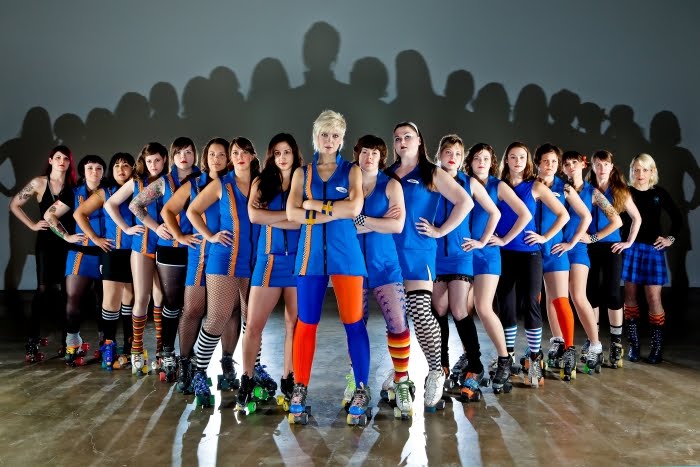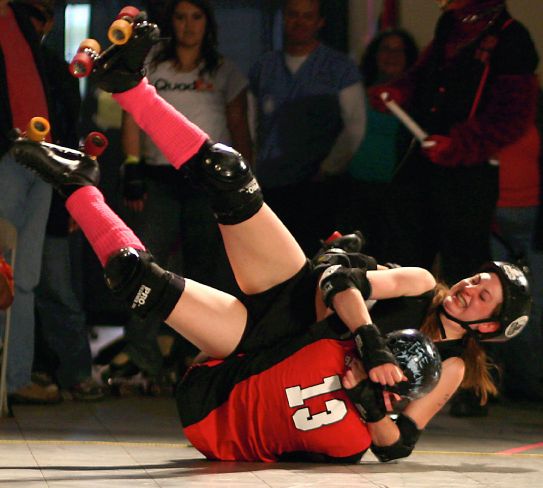★★½
“Will cross rural Argentina off the list of holiday destinations, in much the same way that Deliverance did for North Georgia.”
 I have no problem with rape/revenge movies, providing the balance is skewed more towards the revenge than the rape. Ms. 45, for example, has about five minutes of rape and 60 of revenge. This is fine by me. I am all about the revenge, which should be nasty and brutal, exactly what sexual predators deserve. Actually, so should the rape be, because portraying it any other way is very, very questionable. But that’s something which hardly needs depicting: I’m quite happy taking it as read, thank you very much. Here, the depicted brutalization of four young women goes on far longer than necessary to serve any point.
I have no problem with rape/revenge movies, providing the balance is skewed more towards the revenge than the rape. Ms. 45, for example, has about five minutes of rape and 60 of revenge. This is fine by me. I am all about the revenge, which should be nasty and brutal, exactly what sexual predators deserve. Actually, so should the rape be, because portraying it any other way is very, very questionable. But that’s something which hardly needs depicting: I’m quite happy taking it as read, thank you very much. Here, the depicted brutalization of four young women goes on far longer than necessary to serve any point.
They appear to be heading home from college – it’s a bit vague – when they see a girl lying beside her bike, injured at the side of the road, and some men with guns nearby, who might just be hunters…or might not be. The women load her into the car, only for the victim to die before they reach the next time. They report it to the two-man police force, who seem less that enthusiastic about investigating. As they leave town, they find themselves being chased by the hunters’ truck, and it’s soon very apparent that their intentions are very, very unpleasant.
To be honest, I largely tuned out the middle portion of this, for reasons explained earlier. That said, when the tables are finally turned, it is certainly satisfying, especially in the final moments of vengeance. Bogliano takes his time in all aspects, which is a double-edged sword: some scenes benefit from the unflinching approach, such as the filling in of a grave, which unfolds in real time and is chilling viewing. However, others are simply dull and pointless, for example, the one where one of the girls goes into a bathroom, smokes a cigarette, changes her shirt and leaves. Really. That’s it. There’s a serious lack of characterization as well, to the point that it’s hard to care too much about the victims, as you’ve been given no reason to do so, or insight into their characters.
The film does improve markedly in the final reel, though this may be as much due to my personal prejudices as any actual change in the direction. But the revenge is certainly memorable, in particular the use of a strand of barbed-wire, in another sequence where Bogliano’s unblinking camera lens comes out as a positive. Much credit is due to all the actresses involved, for going to hell and back in the name of their cinematic art, and the overall impact is certainly better than some of the entries in the genre, as linked below. However, it may simply be too brutal, and the tuning-out mentioned above is something likely to be experienced in an even greater degree by viewers that are more sensitive than I.
Dir: Adrián García Bogliano
Star: Gimena Blesa, Magdalena De Santo, Andrea Duarte, Andres Aramburu
a.k.a. No Morire Sola





 To the makers’ credit, they are perfectly up-front about this being made for pennies, with home video equipment and edited on a laptop. But even though I’m not averse to that – heck, I’ve been involved with films on such microbudgets myself – there’s still too much here that’s avoidably bad. For instance, if you are going to put the President of the United States in your film, be sure you have access to someone with a grasp of English that extends past “D+, must try harder”. If you don’t, then leave them out.
To the makers’ credit, they are perfectly up-front about this being made for pennies, with home video equipment and edited on a laptop. But even though I’m not averse to that – heck, I’ve been involved with films on such microbudgets myself – there’s still too much here that’s avoidably bad. For instance, if you are going to put the President of the United States in your film, be sure you have access to someone with a grasp of English that extends past “D+, must try harder”. If you don’t, then leave them out. In contrast to
In contrast to  Not that there is any shortage of said personalities, such as the mother and daughter who both take part in the sport, or the three sisters who have been roller-skating virtually their entire life, and are feared across the entire Seattle league. There are, admittedly stories about romance and marriage included, but even these have a close connection to roller-derby, like the guy who proposes after his girlfriend became part of the championship-winning team [I can relate to this, having proposed to my wife immediately after the Arizona Diamondbacks won the 2001 World Series!]. I also enjoyed the insight into the different teams, like the Sockit Wenches (right) or the Derby Liberation Front, and the different ways in which they both perceive themselves and are perceived from the outside. Each has a different group personality, which of course, attracts other like-minded individuals, reinforcing that aspect of the team.
Not that there is any shortage of said personalities, such as the mother and daughter who both take part in the sport, or the three sisters who have been roller-skating virtually their entire life, and are feared across the entire Seattle league. There are, admittedly stories about romance and marriage included, but even these have a close connection to roller-derby, like the guy who proposes after his girlfriend became part of the championship-winning team [I can relate to this, having proposed to my wife immediately after the Arizona Diamondbacks won the 2001 World Series!]. I also enjoyed the insight into the different teams, like the Sockit Wenches (right) or the Derby Liberation Front, and the different ways in which they both perceive themselves and are perceived from the outside. Each has a different group personality, which of course, attracts other like-minded individuals, reinforcing that aspect of the team. For the next entry, we leap forward to 2009, and Portland – a city which all we know about, we learned from Portlandia. And, on that basis, of course it’s a city which has roller derby, where it sprung, virtually fully-fledged to four-figure crowds. This is less of a landmark doc, in that it doesn’t cover the beginning, middle or end. It’s basically a year or so in the lives of the participants in the Rose City Rollers, which is the Portland league. It covers both their local season, and then, once that’s over, follows the travelling team, the Wheels of Justice, first as they head down to San Francisco to take on their hated rivals, then over to Denver for the regional championships.
For the next entry, we leap forward to 2009, and Portland – a city which all we know about, we learned from Portlandia. And, on that basis, of course it’s a city which has roller derby, where it sprung, virtually fully-fledged to four-figure crowds. This is less of a landmark doc, in that it doesn’t cover the beginning, middle or end. It’s basically a year or so in the lives of the participants in the Rose City Rollers, which is the Portland league. It covers both their local season, and then, once that’s over, follows the travelling team, the Wheels of Justice, first as they head down to San Francisco to take on their hated rivals, then over to Denver for the regional championships. We used to be fairly well into roller derby, and reports of these bouts have previously graced the pages of this site. Our involvement in the scene came to a sudden halt a couple of years back when a shift-change at work left me holding down the fort on Friday and Saturday evenings, which are basically the prime nights for bouts. While the shift has its advantages, it does mean the only bout we’ve seen in about the past five years was one at the Arizona State Fair which happened to coincide with a midweek night off. I still possess my AZRD shirt, which I wear it to work occasionally, and have followed (vaguely) the schisms and ructions as groups have split, flourished and folded locally. Phoenix alone, as well as AZRD, has the Arizona Derby Dames, Arizona Roller Girls, Harmonic Violence Rollergirls, Renegade Roller Girls and Desert Dolls Roller Derby (somewhat) active, more than any other city in the world. I’m unsure whether this splintering is a good thing.
We used to be fairly well into roller derby, and reports of these bouts have previously graced the pages of this site. Our involvement in the scene came to a sudden halt a couple of years back when a shift-change at work left me holding down the fort on Friday and Saturday evenings, which are basically the prime nights for bouts. While the shift has its advantages, it does mean the only bout we’ve seen in about the past five years was one at the Arizona State Fair which happened to coincide with a midweek night off. I still possess my AZRD shirt, which I wear it to work occasionally, and have followed (vaguely) the schisms and ructions as groups have split, flourished and folded locally. Phoenix alone, as well as AZRD, has the Arizona Derby Dames, Arizona Roller Girls, Harmonic Violence Rollergirls, Renegade Roller Girls and Desert Dolls Roller Derby (somewhat) active, more than any other city in the world. I’m unsure whether this splintering is a good thing. Rosa Rubinsky (Baff) is working as a waitress at a wrestling venue, when her swift dispatch of an over-affectionate coworker gets her noticed by a promoter (Bechler). He convinces her to try out, under the watchful eye of Mildred Burke [playing herself – she held the Women’s World Championship for about 20 years], and after some initial shock, discovers she likes the theatrical sport. Despite never having been outside the state of New York, she goes on the road, along with a set of other women wrestlers, and they travel up and down the East coast, putting on shows, though Rosa is still deemed too “green” to get in the ring. That changes after she meets the current women’s champion, Terrible Tommy (O’Brien, another genuine wrestler of the era). A bout for the belt is arranged, in which Rosa – known now as “Rosa Carlo, the Mexican Spitfire” – will take on Tommy for the title.
Rosa Rubinsky (Baff) is working as a waitress at a wrestling venue, when her swift dispatch of an over-affectionate coworker gets her noticed by a promoter (Bechler). He convinces her to try out, under the watchful eye of Mildred Burke [playing herself – she held the Women’s World Championship for about 20 years], and after some initial shock, discovers she likes the theatrical sport. Despite never having been outside the state of New York, she goes on the road, along with a set of other women wrestlers, and they travel up and down the East coast, putting on shows, though Rosa is still deemed too “green” to get in the ring. That changes after she meets the current women’s champion, Terrible Tommy (O’Brien, another genuine wrestler of the era). A bout for the belt is arranged, in which Rosa – known now as “Rosa Carlo, the Mexican Spitfire” – will take on Tommy for the title. If you’ve seen Bollywood films, you might expect the same here – a light, breezy romp, interspersed with gratuitous musical numbers. Wrong, on every conceivable level. It’s an almost unrelentingly grim portrayal of the life of Phoolan Devi (Biswas), sold off by her family at the age of 11, abused by her husband (Shrivastava) as well others in the higher-ranked Thakur caste, and basically treated worse than an animal. She’s eventually abducted by a gang of bandits, whose lieutenant Vikram (Pandey) is sympathetic to her: when the leader tries to rape her, Vikram shoots him in the head, and takes over, making Phoolan his co-chief. However, after the group’s true leader is released from prison, he’s none too happy, and sets out to teach Phoolan a lesson than will make her earlier misfortunes seem like paradise.
If you’ve seen Bollywood films, you might expect the same here – a light, breezy romp, interspersed with gratuitous musical numbers. Wrong, on every conceivable level. It’s an almost unrelentingly grim portrayal of the life of Phoolan Devi (Biswas), sold off by her family at the age of 11, abused by her husband (Shrivastava) as well others in the higher-ranked Thakur caste, and basically treated worse than an animal. She’s eventually abducted by a gang of bandits, whose lieutenant Vikram (Pandey) is sympathetic to her: when the leader tries to rape her, Vikram shoots him in the head, and takes over, making Phoolan his co-chief. However, after the group’s true leader is released from prison, he’s none too happy, and sets out to teach Phoolan a lesson than will make her earlier misfortunes seem like paradise. Wow. This is dreadful, and I speak as someone who enjoyed its predecessor, appreciating its excessive updating of Little Red Riding Hood. Bright tries to capture lightning in a bottle here, this time going for Hansel and Gretel, but it’s largely a miserable failure, imploding in screeching one-note performances from the two leads and far too many scenes of teenage girls vomiting. Yep. Girls vomiting. The scenario has Crystal Van Meter (Lyonne) sentenced to 25 years in prison, by a judge (a cameo by John Landis) fed-up of her petty criminality. There, she meets fellow desperado Angela “Cyclona” Garcia (Celedonio), a teenage serial killer with even more anti-social tendencies. After much binging and purging, the pair break out and go on the lam, heading for Tijuna and Sister Gomez, whom Garcia believes can solve their problems. But the Sister is not quite what she seems… as should be clear when I tell you she’s played by Vincent Gallo.
Wow. This is dreadful, and I speak as someone who enjoyed its predecessor, appreciating its excessive updating of Little Red Riding Hood. Bright tries to capture lightning in a bottle here, this time going for Hansel and Gretel, but it’s largely a miserable failure, imploding in screeching one-note performances from the two leads and far too many scenes of teenage girls vomiting. Yep. Girls vomiting. The scenario has Crystal Van Meter (Lyonne) sentenced to 25 years in prison, by a judge (a cameo by John Landis) fed-up of her petty criminality. There, she meets fellow desperado Angela “Cyclona” Garcia (Celedonio), a teenage serial killer with even more anti-social tendencies. After much binging and purging, the pair break out and go on the lam, heading for Tijuna and Sister Gomez, whom Garcia believes can solve their problems. But the Sister is not quite what she seems… as should be clear when I tell you she’s played by Vincent Gallo.